Adventure
Soldiering With Nature in Dehradun
-Ashwin Baindur
If I close my eyes and lie back, the sound of the Koels and brain-fever birds take me back in time to a sylvan time of my life - the training period in the Indian Military Academy. Once again, I smell the hot, moist wind bringing forth the smell of wet earth
and heralding the onset of a dust storm. The wind, fury, lightning and thunder cools the summer day and a pleasant evening is promised. Each morning I woke up to the plaintive notes of the Indian Cuckoo which sang the first four notes of the old Ventures favourite
- Popcorn. I lived most of my life outdoors in those days. Food, academic classes and sleep - all other times we were out in nature.
Each day we pounded the drill square, sweating automatons, turning together on unheard cues while bulbuls and orioles sang in the trees overhead. In white shorts and singlets climbing up and down ropes and jumping the "horse" while the creepers on the trellis
fence nearby sent silent whiffs of perfume to entice the bees and butterflies. In putties and solar topees, holding on to the horse precariously for dear life, praying that one fell on green grass and not on rocky slopes. Running slowly, tirelessly, unstoppably
along the long miles of the tea estates flanked by sal and oak forests. In the Tons valley, beautiful Common Peacocks, Pansies and Leopards flew all around as we fired our rifles - strangely they were oblivious of the acrid fumes which stung our eyes.
The forests around Dehradun were our battlegrounds. Here we attacked a knoll, there we defended the stony bank of a "rao". We infiltrated across the passes of the Shiwaliks day and night in search of the enemy, unafraid of the big cats but terrified of meeting
the fearsome elephants of Rajaji National Park. We would break off leafy twigs and ferny fronds to break our silhouette and camouflage ourselves. Long hours in the rain we spent digging and preparing our trenches, but always to the dis-satisfaction of the
DS (our instructor). Just when we got it right, he said the tactical situation had changed and now we would form a fresh defensive position in the forest.
The sal forest, looking identical in every direction, especially after dark. One night, I went to answer nature's call and got lost while returning. As taught, I stopped and tried to retrace my actions when I heard the loud bellowing laughter of my battalion
commander, Lt Col
Farukh Bulsara. "Bull" as he was known had a loud voice, immense courage and a great sense of humour. He would lead some of us into a daring airborne attack to capture Male airport in 1997. A great leader, sadly no more. But I'm digressing. That night his voice
acted as a beacon, if he was there, then I knew where to go.
Forever hungry, we would try to eat the berries in the jungle wherever we went, fortunately without any adverse effects. Then one day, I remember our instructor showed us how to catch, kill and cook a snake - it tasted like boiled chicken. That night we went
on survival mode for 24 hours. I was not worried - my buddy, Shyamo Singh, was from Manipur. Once out of sight, he brought out a sling and some 9mm slugs dug up from the rifle range. He brought down three crows - one each. Together with small fish from the
streams, some dal and rice that we had, we made a good meal.
I especially remember one night - it began with a perfect purple dusk. We lay in ambush just inside the edge of a sal copse, waiting for an unsuspecting patrol to ambush. As it grew dark, we kept one eye closed, the faster to adapt to night vision. A cool breeze
blew carrying the delicate scent from some bushes with white flowers along the Rao bank. Then a small light appeared, golden, small, it began to blink. It was not the enemy but a fire-fly. Then another started flashing nearby, then another, yet another and
more and more. All of a
sudden something miraculous happened. They all began to flash together, in perfect harmony. I was amazed, I almost didn't notice the "enemy" patrol approach. I nudged my sleeping partners awake and we sprang a perfect surprise, I swung our "rattler" to depict
LMG fire. Another fired a bicat strip (firecrackers). Then we grabbed our rifles and charged the enemy. We had achieved complete surprise, ruled the umpire; it was indeed a perfect night.
Our next memory is of Bhadraj. This elephant back peak adjoining the left edge of Mussoorie is a real monster. Laden with packs - in mountains, one is supposed to be self-sufficient in food and ammunition for 72 hours, we trudged painfully up the never-ending
slope. We progressed through a variety of ecozones - the forested lower slopes, the bushy intermediates and grass strewn upper slopes. Every time we thought we crested, the actual top of the mountain loomed even higher beyond. In the dusk we summitted - reported
to the
DS. We sat looking westward at the picture-perfect setting sun over the Shivaliks.
By then we were hungry having eaten all our food,; we were dehydrated having drunk all our water. We were completely exhausted. It was a torment to clamber down the mountainside. It was achieved with much slipping, falling, helping one another and finally we
had enough. We were almost at the bottom, we had reached a spring. We slaked our thirst, stopped to rest and fell asleep immediately. In the dim greyness of first light, I was rudely kicked awake - a DS had found us. He asked us how we reached that place?
We gestured over our
shoulders at the slope behind us - he said, "Don't pull my leg!". We turned and looked behind - our jaws dropped. Dog-tired robots, we had blindly followed the zombie like map-reader down a precipice but by grace of the Almighty none of us were hurt. Till
this day, I do not
know how we came down that slope. There was no way, any alert conscious person would even think of attempting that route.
As we trudged down the oak forested slopes, sun rays filtered through the forest leaves, birds sang everywhere, the wild flowers bloomed all around, the water tinkled as it ran down-slope. Dog-tired I was but in sheer heaven.
Nature truly lives in Dehra.
(Ashwin Baindur can be contacted at
ashwin.baindur@gmail.com)
|
Eco-travel
Brown-headed Gulls
-Thomas Chacko
God's Own country, Kerala still has a few beaches tucked away in apparent anonymity which can spring a surprise on nature lovers. So it happened, when I took a stroll on the Nattika beach (Trichur Dist-made famous in the film "Chemmeen").
It was the last week of March, time for any winter visitors to start their long journeys back. But I was lucky! Suddenly came across this mixed flock of brown-headed and black-headed gulls in a desolate corner.
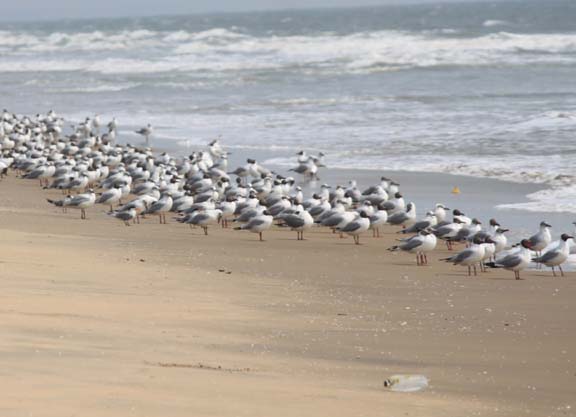
A quick reference to Salim Ali's book of Indian Birds told me that these winter visitors are from Ladakh. They normally arrive in September/October and depart in April. The black-headed gull assumes a dark coffee coloured head by end of March prior to migration,
read the description by Salim Ali. That explains the few black heads in the
flock. I could also spot a few river terns which can be seen among the gulls and of course, do not miss the ever present plastic bottle on our beaches!
The brown -headed gull (wave crow or vichikaka in Malayalam) was also described in the book
Birds of Western Ghats, Konkan and Malabar by Satish Pande and others.
"White wing-tip mirrors, yellow iris, grey-black underwings. Head pale brown when breeding. These masters of wind pick food from the water surface, maneuvering with their broad wings and square tail.
Swim well with webbed toes, elegantly riding the waves in the roughest weather. Clams and crustaceans are reportedly dropped on rocks and hard ground to break them open.Their distribution is on the coasts of Konkan and Malabar, though nesting sites are high
up in the Himalayas."
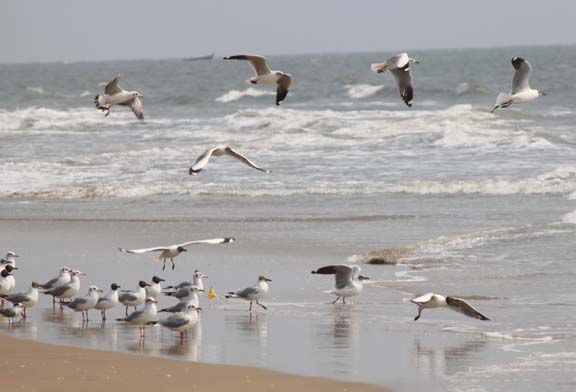
From the same book I also found these cultural notes. Brown- headed gulls are featured in the epic Mahabharata. Sanskrit names Damar and Kharshbdakurar indicate their noisy nature.
A statue of the gulls is erected at Salt Lake City, Uta(U.S.A) in appreciation of their help during the famine when they devoured locusts and saved the remaining crop.
More details of this monument is available at
http://en.wikipedia.org/wiki/Miracle_of_the_gulls
|
Endangered
Monitoring Tigers in the Twenty-First Century India-Part V
-Vinod Rishi
Here is the fifth part of an article published by Shri Vinod Rishi in
The Indian Forester. Vol.136:10. Wild Life Special.
Shri Vinod Rishi is IFS – retd. and a Former Additional Director General of Forests (Wildlife), Govt. of India; E-mail: vinodrishi@rediffemail.com
(B). Application of Field Methods in Census and Research Work
The two field methods to which the field officers who had worked under Project Tiger were exposed used tiger pug marks: one used it as an index for ascertaining individual tiger’s territorial occupancy; and the other, tiger’s identity for estimating tiger populations
in a given area. Over the years the distinction between the two has been mislaid by the current generation of field officers and research scholars, who treat the two methods to be one and the same. A controversy generated by a review of the field censuses
in 1987 killed both methods. The review of the field censuses declared that the field methods using tiger pug marks as a basic index for estimation of tiger populations are unreliable, and give unrealistic and unreliable results (Karanth, 1987, 2003; Day,
Undated; Banks Undated).
(B.I.) The Controversy: Pug marks are not a reliable census index – field methods using pugmarks are defective (Karanth, 1987).
The review of the data from field censuses (Karanth, 1987)
(a). Growth Rates, Density and Biomass of Tiger Populations
Table– 2
Tiger population over the years
|
Sites
|
1972
|
1979
|
1984
|
1989
|
1993
|
1995
|
1997
|
2001-02
|
|
Tiger Reserves
|
268
|
711
|
1,121
|
1,327
|
1,366
|
1,333
|
1,498
|
1,576
|
|
Outside Tiger Reserves
|
1,559
|
2,304
|
2,884
|
3,007
|
2,384
|
|
2,010
|
2,066
|
|
Total
|
1,827
|
3,015
|
4.005
|
4,334
|
3,750
|
|
3,508
|
3,642
|
Compilation based on the periodic reports of ProjectTiger Directorate, Govt. of India.
After analyzing the data from the tiger census figures for 1972 and 1984, and using the information from the research work of some wildlife research scholars in and outside India, the review concluded:
i. Between 1972 and 1984, the census figures show phenomenal growth in tiger numbers over the years in almost all parts of the country:
The Indian tiger population had more than doubled: from 1,827 in 1972 to 4,005 in 1984. There was an exponential increase in the growth of tiger populations in 11 (sic) original Project Tiger Reserves and 14 States of India. Even relatively poor tiger habitats
like Bandipur showed high growth rate of 14%, per annum for over 12 years in succession. The research studies by Schaller in Kanha National Park, Sunquist and Smith in Chitwan National Park and Chitwan Region in Nepal indicate that the growth rates of tiger
populations in excess of 6% were abnormal.
ii. The 1984 census data indicated excessive densities and biomass reached by tigers in Indian tiger reserves.
a. The density of tigers recorded in the research studies by Schaller, Sunquist and Smith in the tiger habitats in Kanha in India, and Chitwan in Nepal, showed that in well protected habitats tigers may reach densities that range between 17 km2 to 11 km2
per tiger; Overall, the densities in Indian tiger reserves ranged between 54.84 km2 per tiger in the Indravathi tiger reserve, and 5.97 km2 per tiger in the Corbett tiger reserve in 1984; The census figures showed that 6 out of 18 tiger reserves, namely, Corbett,
Bandhavgarh, Dudhwa, Sunderbans, Kanha, and Ranthambhore tiger reserves, had tiger densities that ranged between 10.89 and 5.79 km2 per tiger, which exceeded the stipulated range.
b. The tiger biomass in the above mentioned 6 tiger reserves – the Corbett, Bandhavgarh, Dudhwa, Sunderbans, Kanha, and Ranthambhore tiger reserves – exceeded 10 kg/ km2 whereas a really superior habitat can only support a tiger biomass of 7 to 10kg/km2.
Overall, the tiger biomass in the tiger reserves in India ranged between a low of 2.08 kg/ km2 in the Indravathi tiger reserve and a high of 19.58 kg/ km2 in the Corbett tiger reserve.
-To be Continued
|
Endangered
Monitoring Tigers in the Twenty-First Century India-Part IV
-Vinod Rishi
Here is the fourth part of an article published by Shri Vinod Rishi in
The Indian Forester. Vol.136:10. Wild Life Special.
Shri Vinod Rishi is IFS – retd. and a Former Additional Director General of Forests (Wildlife), Govt. of India; E-mail: vinodrishi@rediffemail.com
The Question of Monitoring Tigers for Tiger Conservation
The shift from field methods to statistical models has, apparently, made no improvement in the monitoring of tiger populations and habitats. The process for search and documentation of even the basic information needed for the conservation of tiger and other
elements in its habitat has become tardy, time consuming, heavy on manpower, uneconomic, unverifiable, time warped and hence redundant and unsustainable. At the least, the field methods were providing results that could be challenged and subjected to verification;
but the current approach is beyond any cross-checking. The choice is: take it or leave it!
Both academic as well as field approaches have been tried out in India, and have been found to have their respective strengths and weaknesses in their application in the monitoring of the populations of tiger and associated wildlife. A quick appraisal of the
two may help in providing an approach for monitoring their populations by acquiring the strengths of the both for immediate use.
(A). Application of Statistical and System Analysis Models
One has to start with the understanding that Statistics is a tool and not an end in itself; and that the statistical models create virtual reality. Even though, in India, attempts were made to promote the statistical models and systems analysis approach in
the first half of the 1980’s (Saharia, Undated), it did not find ready acceptance in the field of wildlife management, even after the advancements and improved availability of computer software and techniques. The chance factor, or probability, gives a feeling
of unreliability to the users, who find field methods giving a better and more tangible picture of the objectives they are concerned with.
The reliability of the statistical models used in the systems analysis approach depends on what information is being fed to the model designer. A model is nothing more than “…an abstraction of the true experimental situation, representing all relevant features
of reality. When used in population estimation, the model will be constructed in such a way that the unknown quantities are expressed in the terms of known or observed quantities” (Overton, 1971). “The first step to successful Systems Analysis is the careful
identification of questions to which the model is to be addressed.” (Overton, 1977). But its acceptability depends on the confidence it can generate in the mind of the user – in this case the wildlife manager.
Systems, especially natural systems, are large and hierarchical, i.e., composed of complexes of systems within systems. The modeling approach depends upon simplifying the systems by assumptions so that models can be derived and solved. But systems analysis
and modeling approaches greatly depend upon the accurate assessment of complex system questions. There is intractability of very large systems for development of differential equations, the difficulty of defining modeling parameters, and obtaining data appropriate
to models. The behavior of a larger system can be understood only to a limited extent from the next lower hierarchical system; it is not a reliable way to predict the behavior of larger system by studying the next lower hierarchical system. “Moreover, the
system properties emerge not only from their components but also from their linkages. As the systems become larger and more complex, our ability to predict system behaviour becomes less certain.” (Reed, 1995).
It follows that the enormous diversity of the tiger occupied ecosystems in India poses a formidable challenge for application of a hypothetical hierarchical model developed in one or two landscapes to the entire range of diverse ecosystems. Models for Satpura-Maikal
landscape cannot be applied to the mangrove forests of Sunderbans or Terai grasslands, or tropical evergreen and semi-evergreen rain forests, or desert and scrub ecosystems. On the acceptance and applicability aspects, a system’s properties are meaningful
for the user only in terms of the hierarchical level in which he is interested.
The reliability of population estimation at field level is closely linked with the reliability of the process of construction of a model. Modeling is an art. The research work and refinement of Systems Analysis, and statistical sampling approaches is massive
in the U.S.A. The adaptation of models developed in other countries, and honed with experience in Indian ecosystems – as has been done in Nagarhole in south India – is encouraging. But it does not obviate the need to develop further experience by working in
other biogeographically and ecologically different landscapes. At present even the basic research in the Indian tiger habitats is patchy and inadequate for developing models one can confidently apply in India.
The current model adopted by the NTCA for evaluation and monitoring of the status of tiger populations needs significant improvement to provide accuracy, validity, and conceptual rigor of the outputs needed for effective management of tiger conservation in
India.
-To be Continued
For earlier parts of the article click on the links below
Monitoring Tigers in the Twenty-First Century India-Part I
Monitoring Tigers in the Twenty-First Century India-Part II
Monitoring Tigers in the Twenty-First Century India-Part III
|
Events
Pollinators and Pollination in a Changing World
A Workshop from 7th to 11th March, 2011, Bangalore
Call for Applications
Applications are invited from students working in the fields of ecology, evolution and
conservation to apply for participation in an upcoming workshop, to be conducted at the National Centre for Biological Sciences, Bangalore.
To apply, please send your résumé and a brief write-up (of no more than 200 words) on how this workshop will be useful to you, to:
pollinatorsworkshop@ncbs.res.in
Participation is based on selection that takes into account each applicant’s academic background and plans. Fifteen students will be selected for the workshop. All participation costs (travel by 2-tier AC train, accommodation, and daily allowance) of selected
students will be covered by workshop organizers. We will begin reviewing applications on 18th February, 2011.
*Workshop Details*
This 5-day workshop will introduce students to a range of topics important in the interactions between flower visitors (particularly bees) and flowering plants, both in natural and agricultural systems. A good understanding of plant-pollinator relationships
can only be obtained from insights into the needs of both pollinators (obtaining food, shelter, etc.)
and plants (obtaining high-quality cross-pollination of its flowers).
This course will address many aspects of this complex relationship, including foraging behaviour, sensory and community ecology of pollinators, floral rewards, plant-pollinator networks, and plant breeding systems. In addition, we will address the current state
of pollinators and plants, how global change affects this relationship, what it means for human society, and what we can do about it.
*Coordinated by:* Koos Biesmeijer, Bill Kunin (University of Leeds), &
Stuart Roberts (University of Reading).
*Organized by:* UK-India Education and Research Initiative with University
of Leeds, Nature Conservation Foundation, Indian Institute of Science
and
National Centre for Biological Sciences.
Are you a tree-watcher?
-Anywhere in India, Any time
Do you love the beautiful trees in your garden, on the roadsides, and where you study or work? Would you like to contribute to a better understanding of our trees?
SeasonWatch (http://www.seasonwatch.in), is a citizen volunteer network that monitors the seasons as revealed by trees. They document the timing of flowering, fruiting and leaf-flush of roughly 100 tree species, and explore how this timing may be changing
as the climate changes. There is no long-term information of this kind from India, so you can contribute a better understanding of nature by simply watching the trees you love!
Just identify a tree (or more) near you and monitor it every week. Upload this information through your account on the SeasonWatch website to add to the data collected by volunteers all across the country. Any interested person can take part -- no specialist
knowledge is required.
SeasonWatch is a purely non-commercial and free activity; its purpose is to understand changes in the natural world; and the information collected is open to all. In the future, they will have a sub-programme for schools and other groups; a discussion board;
and ways to search, visualise and download all information collected by SeasonWatch volunteers.
Please join today, and let a friend know as well!
http://www.seasonwatch.in
Suhel Quader, Arun Elassery and Uttara Mendiratta
Citizen Science Programme
National Centre for Biological Sciences
http://www.ncbs.res.in/citsci
Sreekanth Sreedharan and Prakash Iyer
Wipro Applying Thought in Schools
http://www.wiproapplyingthoughtinschools.com
GIBY KURIAKOSE PhD
Ashoka Trust for Research in Ecology and the Environment (ATREE),
Royal Enclave, Jakkur Post, Srirampura
Bangalore- 560064, India
Phone - +91 9448714856 (Mobile)
Madhura Niphadkar
Sr Research Associate
Ashoka Trust for Research in Ecology and the Environment (ATREE)
Ph. No. +91-80-23635555 Ext 309.
Website: www.atree.org
Did someone say, Strength, Stamina, Speed are the domain of Men???
Challenge them!!!
-Pune, 8th March
Announcing an ALL WOMEN Rafting Tour on Kundalika. Can there be a better way to celebrate Women's Day???!!!
We at Kundalika Rafting, would like to offer this special batch exclusively meant for Women across Pune and Mumbai, to participate and experience the thrill of Rafting, on the day that is meant for them.
Program details:
0530 hrs Leave Pune (Packed Breakfast enroute)
0800 hrs Reach & Report @ Kundalika starting point (Rafting)
0830 - 0930 hrs Pre rafting session, Gear-up, Rescue techniques,
Synchronization and set for rafting
0930 hrs Rafting session on river kundalika after the release of water from Bhira dam.
1130 hrs Reach Rafting End Point. Leave for the Lodge for Lunch.
1245 hrs Reach the Lodge & Rest
1300 hrs Buffet Lunch
1400 hrs Rest & Leisure Time
1445 hrs Group Games
1745 hrs Evening Tea Coffee with snacks
1830 hrs Leave for Pune
2100 hrs Reach Pune
Charges: Rs. 1800 (per participant)
For More information & Registrations Contact:
PUJA - 9272882874, NIKHIL - 9011344536, BISHWAJIT - 9049544975
Mail to @ info@kundalikarafting.com / sales@foliageoutdoors.com
|
Events
Stream Trail at BNHS nature reserve (BNR), Mumbai
Saturday, April 2 · 7:00am - 11:00am
Registration: On the spot.
BNHS nature reserve expanse over 33 acres at the edge of Sanjay Gandhi National Park near Goregaon Film City, the trail takes you through a dry stream bed and then onto the leopard trail, one can expect to see Ant Lion, Emperor Scorpion, Plum-headed Parakeet,
Greater Racket-tailed Drongo, Greater Coucal, Shikra and many more.
Charges: Rs. 50/- for member and Rs. 100/- for non-member
Meeting Point: Members to meet at CEC, Goregaon (east) at 7.00 a.m.
Please carry adequate water and packed breakfast. The programme will conclude by 11.00 a.m.
How to reach: Take the bus number 343 from Goregaon (East) railway station or Dindoshi bus Depot to Film city bus stop and walk down to BNHS CEC (2 mins walk through the forest gate). You can also hire a rickshaw
LINKS for the Google Map WALK FROM RELIANCE MEDIA TO BNHS RESERVE
http://bit.ly/waytoBNR
DRIVE TO BNHS RESERVE http://bit.ly/drivetoBNR
Tungareshwar Wildlife Sanctuary, Maharashtra
Sunday, April 3 · 6:00am - 12:00pm
Registration*: Call at Hornbill House 22871202, 22821811 or e-mail at
bnhs.programmes@gmail.com
Spread over 85 sq. kms, Tungareshwar wildlife sanctuary forms a corridor between SGNP and Tansa wildlife sanctuary. Three different types of forest, Dry deciduous, Moist deciduous and Semi Evergreen forest are seen here. 2011 being the International Year of
Forest, participants will be informed about the forest types found in the Indian sub-continent and their importance.
Charges: Rs. 550/- for BNHS member and Rs. 600/- for others
(Charges include transportation and BNHS expertise).
Reporting: Bus will leave from Goregaon (Oberoi Mall) at 5.30 a.m.
Dadar T.T. (near Chandu Halwai) at 6.00 a.m., Chembur (near Diamond Garden) at 6:20 a.m., Thane (Cadbury Jn.) 6.40 a.m. Patlipad bus stand
(Hiranadani Junction on Ghodbunder rd.) 7.00 a.m.
Note: Please carry adequate water and packed breakfast,Be prepared for a hot day.
Croc Bank Weekend Summer Camp, Chennai
Friday, April 8 at 8:00am - July 2 at 5:00pm
Despite the multitude of summer camp options open for kids, finding something close to home but far enough from the mundane is difficult. Madras Crocodile Bank Trust, fondly referred to as Croc Bank, has some interesting activities planned for young aspiring
naturalists this summer. The in–house herpetology experts, reptiles themselves and the
croc bank environ are used to the fullest to sensitize the young minds on issues related to ecosystems and reptile conservation.
The two-day long summer camps offer an opportunity for youngsters to interact with herpetology experts, gain theoretical and practical know-how of the reptile world and additionally, enjoy the charms of reptiles in their slightly more active, nocturnal avatar.
Be it trekking through the scrub jungle with the Irulas looking for snakes or visiting the nearby flying fox colony or being launched into the world of traditional medicines, there is never a dull moment for enthusiasts. Also, there are the certificates and
goodies to take home.
For those of you, who feel that these camps are a great way for your kids to spend their summer, please contact
Gayathri Selvaraj,
Education Officer, Madras Crocodile Bank.
Duration: Every weekend from the 8th of April to 2nd of July 2011
Contact Details:
Email: education.mcbt@gmail.com or gayathri@madrascrocodilebank.org
Mobile: +91-9840675175.
"GREENSCRAPS" ... Nature Journaling Workshop, Bangalore
Monday, April 11 at 7:30am - April 15 at 10:30am
"GREEN SCRAPS" is back ! After a wonderful Nature Journaling Workshop in October, 2010, we are happy to announce yet another exclusive "GreenScraps" workshop this
summer !
The registrations are limited to just about 10-12 participants.
To know more about the workshop, call :
Shilpashree - 9241449073
Sangeetha Kadur - 9886812598
Age bracket - 8 to 13 yrs
Young Naturalists' Workshops 2011 - Naturalist Skills at Romulus Whitaker’s
Monday, April 11 at 5:00am - April 15 at 3:00pm
Rom Whitaker is a pioneer in reptile conservation and has been at the forefront of the field for around four decades. He founded the first snake park in India, the Madras Crocodile Bank Trust, Andaman and Nicobar Environmental Team, Irula Snake Catchers’ Co-operative
Society among many other achievements and endeavours.
Rom now lives on the edge of a reserve forest about an hour away from Chennai. He has set up a small campsite to allow enthusiasts to experience Nature and also build skills in field biology.
Gerry Martin will be taking a group of 18 kids over to Rom’s campsite to run them through the basics in field biology. They will learn outdoor skills, camera trapping, bio-statistics, reptile biology, bird watching and a lot more.
Age bracket: 10 to 16 yrs.
Book in advance
Agumbe in the heart of the monsoons!
Friday, June 3 at 8:00am - June 5 at 6:00pm
*Experience the life giving rains*
The beginning of June is a very interesting time in the Western Ghats. Everything is prepared for and waiting for the rains to come. The few early showers have already caused an explosion of life and amphibians and insects abound. Snakes, lizards and other
small predators come out in great numbers to feast on this abundance and many species will have timed the arrival of their progeny with this season.
Gerry Martin will be heading up to the Agumbe Rainforest Research Station to experience this transition. We will be staying at the research station, in tents and explore the surrounding streams and forests to understand how various animals adapt to this wet
clime. By July, the rains in Agumbe are punishingly heavy and most life seems to simply hunker down and wait out the next two months and potentially six meters of rain!
This is the perfect time to experience the smaller wildlife and see various interactions and adaptations. We will also learn about taxonomy of reptiles, ecological research
methods, outdoor skills and guidelines for safe functioning in the wilderness.
The workshop will be a combination of activities and presentations.
Some of the aspects we will address are:
• Rainforest ecology
• Canopy Access
• Stream Ecology
• Snake Taxonomy
• Snakebite treatment and first aid
• Night survey techniques
We will stay in tents set on concrete platforms with a tarpaulin shelter over them. The bathrooms are permanent structures with hot and cold running water.
Program Dates: 3rd to 5th June, 2011. (The group leaves Bangalore by overnight bus to Agumbe on the 2nd night and returns early in the morning on the 6th.)
If you are interested in joining or need more details, please get in
touch with Gerry on gerry@gerrymartin.in.
Manali - Leh - - Kargil - Srinagar - Jammu Bike Safari
Saturday, July 2 at 3:30pm - July 17 at 9:00am
13 days/12 nights of nomads life 2000+ Kms of riding on the roads as good as no roads
Riding on "Worlds Highest Motorable Road"
Crossing top 3 highest motorable pass of the world Riding on the succession of 21 hairpin bends Sleeping at an Altitude of 14,500 ft
A drive for 12 hours, and the number of vehicles you see is about 20… Plains for about 40 kms straight at 12000 ft above the sea level… Raw, brown huge mountains without any green…A sky full of stars and there are so many that if you start counting you can
easily loose count in 3 seconds…A lake which is dark blue in colour in the afternoon, grey in the evening, and silverish in the morning, is 154 kms long and 4 kms wide
at its maximum width…A Camp in the middle of nowhere...Mountains where clouds paint their shadows…
Contact - 020 25443096 / 25443097 / 9850826431
or Devdatta Mulay - 9423041586
|
Green Defenders
Eco-friendly Holi
-Prajakta B Rain
Holi is rightly known as the festival of colours, it signifies the arising of good over devil represented as holika dahan. In Sanskrit the festival is termed as ‘dhulivandana’ and in Bengali and Orriya “dolayatra”. The story goes that Hiranyakashyapu
the king of demons considered himself as supreme God ,and he banned the worship of Vishnu in his kingdom. Prahlad was his son who continued worshiping Vishnu. Hirnyakashyapu made repeated attempts to kill Pralhad and took the help of his sister Holika, who
had a boon that she cannot be touched by fire. However the unexpected happened and Holika turns into ashes, Pralhad emerged victorious. Holi is celebrated in memory of this day. This festival was celebrated by our ancestors in order to unite the society,
they used to clean their colonies and houses and make a bonfire of the waste collected. Burnt along with neem leaves and dry cow dung, the fumes also served the purpose of purifying the air around.
The festivities have now taken a life of its own and it is not unusual to find people cutting down trees for making the Holi bonfire.
A survey said that near about 35,000 bonfire happen in a single state and each bonfire needs more than 100 kg of wood. Artificial colours red, pink ,yellow ,blue ,green, black, silver and golden that contain poisonous chemicals like aluminium, bromide, mercury,
lead-oxide (causes skin disease, eye infection and respiratory disorders) are used with abandon. Thousands of litres of water go waste in the water pumps. Soil and water pollution take place because of these chemicals and fumes.
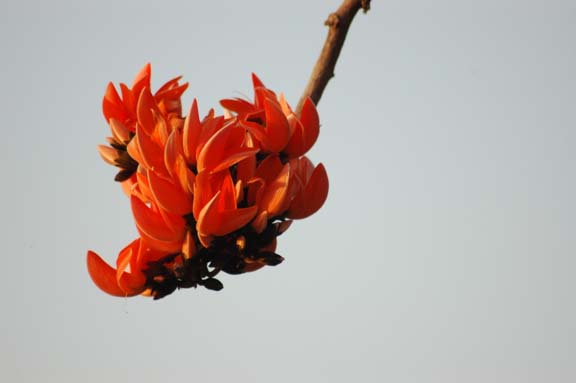
Palas Flower
Eco-friendly Ganpati and Diwali are slowly catching on and we can celebrate eco-friendly Holi too, by avoiding tree cutting and using artificial dry colours. We can also make symbolic bonfire or small bonfire; avoid separate bonfire for every house and lit
one small bonfire for whole society or city. Instead of trees we can use waste material to burn. One single plant gives oxygen which is enough for 10 people and store 2.6 tonnes of CO2. we can easily make natural herbal colours at home only by using flowers
and fruits.
Red----------------------------------------Red hibiscus, Rakatchandan
Yellow-------------------------------------Turmeric
Blue---------------------------------------Blue Jacaranda
Pink---------------------------------------Beetroot
Green-------------------------------------Mehendi
Saffron------------------------------------Palas
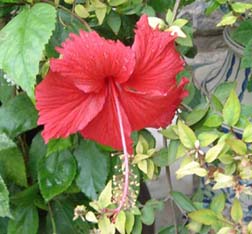
Celebrating Holi in an eco –friendly way, also means victory of good over evil.
( If you know people who work for wildlife rescue and conservation share with us by mail by sending photos and a paragraph about the work, information, achievement in wildlife conservation etc, so that others get motivated
to do the same. Thank you.
The details may be sent to Prajakta.greendefenders@gmail.com
copy to susan_sharma@hotmail.com )
|
Green Defenders
Rescue of black buck
Black buck rescue at Ramtek, a small village of Maharashtra, on the 5th of Feb 2011.
One villager found a black buck in his the agriculture field, black buck was not able to walk. The villagers helped black buck to walk but couldn’t help him out. They called People For Animals Amravati. Mr.Angad Deshmukh, member of PFA Amravati, called forest
department Amravati DFO Mr.Kadam. Help came quickly by means of a rescue vehicle. When they reached there to rescue the black buck now in primary observation by a local vet, it was said to be a case of poisoning.
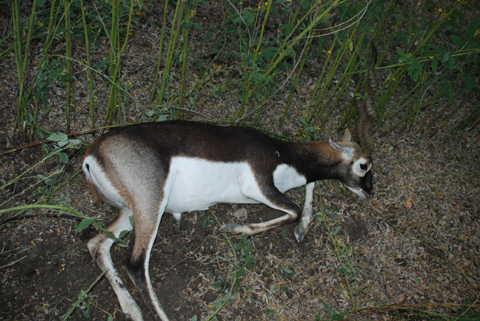
Vehicle was not able to reach up to the black buck; so the rescue team asked villagers for bullock carts to take black buck out from the agriculture field, but villagers refused. (?)
Finally rescue team members Mr.Angad Deshmukh ,Mr.Bhushan Chaukhande and Mr.Vicky Pohadre pitched in make rescue successfully. DFO Kadam, RFO Kavitkar, helped the rescue team and handed over black buck to Akola forest division for further treatment. Black
buck is protected in the Indian wildlife protection act 1972 under schedule one.
Rescue team said “due to less equipment and facilities and without support of villagers,it’s very difficult to do rescue of animals, as forest department also have very less equipment”. This is a common story in Vidarbha region in Maharashtra which has dry
deciduous forest. The area is plagued by less availability of food and water sources due to deforestation and man-made forest fires. Wild herbivorous migrate toward the agriculture fields in search of food and water. Farmers use insecticide to protect their
crop. Chemical insecticide is very harmful to animals. It is poison to animals when they graze in the agriculture field. The resultant conflict between farmer and wild herbivorous is rising continuously.
There is need to protect forest area, stop illegal grazing inside the forest by villagers.
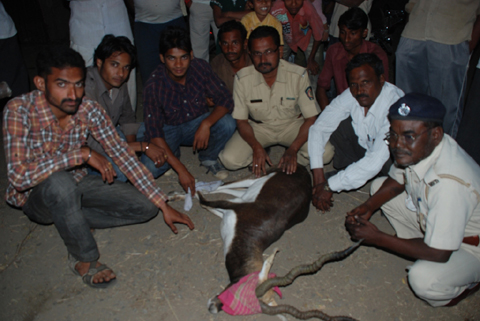
By-Prajakta Hushangabadkar
[Photos by Angad Deshmukh]
If you know people who are doing same work of rescue and wildlife conservation, you can share their work and achievements with us. So others get motivate to do same job of wildlife conservation. Mail at- prajakta.greendefenders@gmail.com and copy to susan_sharma@hotmail.com
Thank you.
|
Marine Resources
Marine Resources of India-Poster feature
India is surrounded on three sides by water. How many of us care to know about the treasures that surround us? Here is a poster on the marine ecosystem created by the Zoological survey of India. For those of you interested in a free wheeling chat on our
marine resources, here is a link to our chat on "Conservation of Marine Diversity of India"
http://www.indianwildlifeclub.com/chat/chat-archive.aspx?cid=79
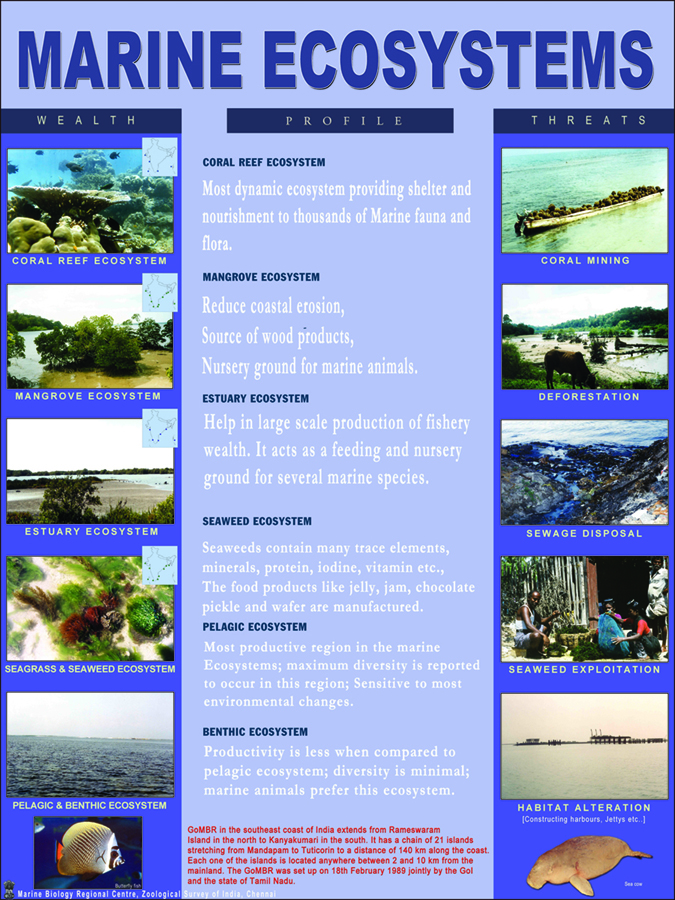
|
Members Speak
RUNNING FOR LIFE
-Vinod Rishi
Shafts of golden sunlight lit the green vault of sal forest behind my house. Summer was at its peak, and sal trees had been shedding their leaves. The forest floor wore a yellow-brown carpet of dried leaves. Through it snaked a vague deer path. Wary of
making noise, I advanced, treading softly on the path. My ears caught faintest of the jungle sounds – the buzzing flight of a bee, the scrape of a lizard’s claws, and the faraway flutter of wings. Even more than my ears and eyes, I was alive to the spirit
of the forest – I could feel the forest.
Suddenly, through the corner of my eye, I saw a small patch in the pattern of shade and light on the ground, fifty feet to my left, ruffle for a moment. I thought I might have imagined it, but I wanted to be sure; for one must not ignore small messages
and little signs the forest gives to the one who wants to be there. I froze. I did not turn my head for a better look, waiting for it to happen again.
Moments, stretched out like minutes, beat past my heart. It happened again; a spot of light in the dappled leaf bed twitched. I slowly turned my head to have a better look. There she was: a leopard suckling her two cubs as she lay on her side with her back
toward me. I could see her through the thin screen of a lantana bush in which she lay. Filtered down through the green canopy of leaves the rays of sun etched out her youthful form with a golden sheen. Her flank rose and fell rhythmically as she slowly drew
in and let her breath out. The heads of her two cubs were just visible over the curve of her body. It was the little white spot at the end of her long tail that had caught my eye as she twitched the tip of her tail in contentment.
A wave of fear and surprise shook me. I did not expect this part of the forest to be inhabited by a leopard; there wasn’t enough prey in it to sustain a leopard. People had killed and eaten away most of the wild animals that a leopard hunts for food.
But there they were: a mother and her two cubs. I know a mother can fearlessly face any threat to her children; and here was a mother armed with razor sharp claws and dagger-like fangs. I feared that she would resent my intrusion. It is different when you watch
a leopard in a zoo. You watch it from the safety of a viewers’ gallery. But if alone and unarmed you meet her on her ground with nothing to stop her charge, you do not want to catch the attention of a loving and caring mother leopard with her cubs. Pound for
pound, a leopard is said to be the strongest of the big cats of the world. You would rather enjoy the sight of a beautiful spotted big cat playing with her cuddlesome babies in a zoo.
One of the cubs happened to peer over the reclining body of his mother. Its eyes locked on me. I might have made some movement that had caught his eye. It stopped feeding. The mother stood up and turned a reproachful eye toward me. For a fleeting moment she
drew her ears back, flat against her head; and cast an appraising glance at me. Her mouth slightly ajar, a faint growl came out of it; but her eyes said she was not alarmed. Without wasting another look at me, she turned and led her cubs away from me; deeper
into the lantana thickets, and was out of my sight.
I turned back; elated and content at the beautiful sight I had just witnessed in the forest behind my house. I felt I should take a chance to see them again early next morning. But I did not get my chance.
-contd.
|
Nature and wellness
Naturefor mind and soul
-Sharada Balasubramanian
When was the last time you saw a little butterfly gently flapping its wings, fluttering from one branch to another, sipping nectar?
Do you listen to the song of birds? Butterflies, birds, trees, leaves and greenery more seem like a dream and a thing of past in human lives. In the world of today, where the human mind, body and soul is so connected with indoor life, be it at office, school
or working out in an artificial environment such as gym, nature seldom plays any role in our daily lives. Is that a reason why stress, depression and psychological problems are on a rise today? The solutions for these problems are easy though - in nature’s
way. John Muir and Henry David Thoreau wrote about the benefits of spending time in theAmerican wilderness in the 19th century which led to the establishment of the first national parks.
Scientists and environmental psychologists talk about how nature can have a great impact on the ‘minds’ of people. An
article in Environmental Science & Technology states finding from a study that just five minutes ofexercising in a green environment will impact the mental health of an individual.
Five minutes of the newly coined term ‘green exercising’ can boost one’s self-esteem. The authors of this study were able to scientifically prove that activities relating to nature such as, cycling, fishing, gardening, walking or even farming in natural settings
contributed to the mental well-being of an individual.
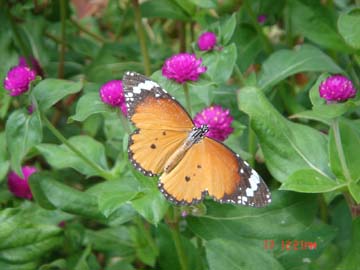
Though people from all ages benefited from being with nature, people who specifically suffered from mental illness were able
to witness some positive changes. Also, walking in green environment helps in improving concentration abilities among children and in some cases, this has proven to be more effective than medication. Today, education psychology also discusses the importance
of nature and their exposure to one’shealth. Also referred to as ‘restorative environments', green space helps people’s mental functioning and social relationships. Environmental psychologists have emphasized that nature restores attention and mental focus
and also helps in recovering from mental fatigue.
Studies reveal that office workers with a view of nature liked the jobs more,
had better health and reported greater life satisfaction. Even a glimpse of nature outside a classroom window would lead to similar benefits in school children.
Let us give an example here. A study was conducted to establish a direct connection with nature and the ability to recover from
psychological stress. A forty five minute task was given to some randomly chosen participants. This was to exhaust their attention levels. After the stipulated time, some participants were asked
to walk in a local nature preserve. Some others read a book and some walked in the urban area. People who walked in the nature preserve performed better than others on a standardized proof reading task. They also reported more positive feelings and less
anger.
Children suffering from Attention Deficit Disorder have a better focus after outdoor activities like fishing, hiking,
and sports, in comparison to children watching television and playing video games.
A recent study from UK found that more than 75% of people who live in urban
areas, are facing drastic mental health problems, and this is a result of detachment with nature. Roger Ulrich, a researcher conducted an experiment to explain that patients suffering and recovering from identical operations were more likely to recover quickly
if they had a daily view of nature from their hospital beds.
According to research from Netherlands and Japan, people living close to
green spaces live longer and enjoy better and healthy life. Another Swedish study says that if employees could view greenery through their office windows, it significantly reduced the stress during their working days.The
psychological value of open spaces in particular has been acknowledged from along time.
According to findings from the green exercise, experience in wilderness leads to people learning to respect other people and
nature. Wilderness trails also leads to changes within one’spersonality. People become more humble and a part of nature. A sense of simplicity, reduction in mind chatter, openness and affability, self-motivation, and self-determination are some qualities
which are developed when people are exposed to wilderness.
It’s time for urban souls to reconnect to nature, to feel and live and bond with the environment to absorb the energy and positivity
that it can give. It can change a day and an entire life!
SharadaBalasubramanian is a journalist, writer, nature lover and a wanderer. She has been writing on environment
and wildlife, green energy, business, travel, social issues, social entrepreneurs, to name some. She works with wildlife scientists to know and understand the issues of wildlife and has many articles to her credit. She maintains a blog calledwildlifemusings.wordpress.com.
|
Poem
Flowers in Spring
Me and you
In the lap of the mountains,
Under the watchful eyes
Of Mother Nature
The vast spread of forest
Beckoning us with open arms.
The petunias, the dahlias,
The gladioli, the flocks
The poppies, the hollyhocks.
The butterflies like pansies,
The bridal white of daisies,
The cacti in variety crazy
Intoxicating us with exotic colours
and a vivid mix of fragrance.
The parakeets and pheasants,
The chorus of crickets,
Bees, mites and insects.
Amidst the scintillating view
Of tall towering pines,
Fills our hearts
With abiding joy.
I throw my arms up
Watching the radiance of
The morning Sun
And give a cry of exhilaration.
By Bhakti Sharma
|
Poem
Chaubattia Gardens, Ranikhet
By Bhakti Sharma
Leave me alone
In the dense wild jungle,
Let me stand still
Let me watch
Every tree,
Rooted yet free.
The herbs and shrubs,
The myriads of deodars
The unusually tall surai,
The eucalyptus and poplar,
All wearing a green cloak,
With the pines and oak.

The poison ivy overgrown,
The red flower of the rhododendron.
The apple and plums,
The peaches and chestnuts,
The figs and walnuts.
The jungle berries
The fruitless cherries
All in lovely green attire.
Laden with fruits
Only to be admired.
An eerie silence,
Broken by rattling of leaves,
Below my feet.
All around me
Law of Nature enforced in a jungle,
Followed by trees
Obeyed by the beasts
O what an unforgettable treat!
( 10kms from Ranikhet, Uttar Pradesh, India, Chaubatia is full of gardens and commands a fascinating view of the Himalayas. Spread over 265 acres of land, it is one of the largest horticulture gardens in the country.
Bhakti Sharma can be contacted at bhakti_sharma@yahoo.co.uk)
|